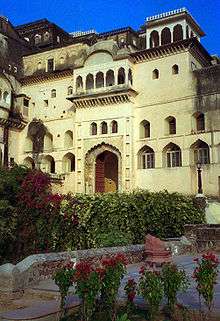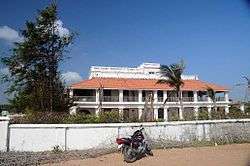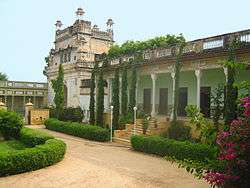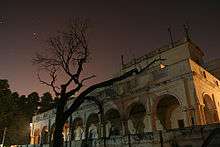Neemrana Hotels
The Neemrana Hotels is an Indian organisation, noted[1] for restoring ruins and turning them into heritage hotels.[2][3]
| Private | |
| Industry | Hospitality |
| Founded | 1991 |
| Founder | Aman Nath and Francis Wacziarg |
| Headquarters | A20, Feroze Gandhiji Rd, Block A, Lajpat Nagar II, Lajpat Nagar, New Delhi, Delhi 110024, New Delhi , |
Number of locations | 13 |
Area served | India |
Key people | Sonavi Kaicker (CEO) |
| Revenue | 50 Cr |
| 45 Cr | |
| 5 Cr | |
| Owner | Aman Nath |
Number of employees | 751 |
| Website | Official site |
History
Neemrana Hotels company was established in 1991 by Aman Nath and Francis Wacziarg. Aman Nath was a post-graduate in medieval Indian history from Delhi University,[4] and Francis Wacziarg a former French diplomat and resident of India since 1969, and they were researching wall frescoes for writing The Painted Frescoes of Shekhavati,[2] when they encountered the 15th-century Neemrana fort on the Aravalli range in Rajasthan. The fort was built by local chieftain Nimola Meo,[5] and had been a ruin for 40 years. They bought the fort for Rs 700,000 in 1986[6] and restored it, opening as a hotel in 1991 with 12 rooms.[7] Following this restoration, the hotel has been used as the venue for the International Festival of Indian Literature in 2002, for Mastermind India, and for several Indian weddings.[2]
Restoration process

The modifications made to the ruins to retain a consistent design include basic amenities like plumbing and air-conditioning hidden from view, and designing 19th-century rooms in the colonial style[6] They call their hotels "non-hotels", to emphasise this design.[5] The buildings are restored in phases, with revenue from guests of restored parts being used to restore the rest.[7] Along with their practice of using local artisans and materials, this keeps costs low, and their hotels break even in two to three years rather than the industry average of seven to eight.[2]
Heritage properties
15th century Neemrana fort was the first property acquired by Neemrana Hotels in 1991 which they gradually restored. Subsequent to their success in restoration of heritage property, the Punjab government transferred the Baradari Palace in Patiala to them as a public-private partnership, and the Rajasthan government leased them the Tijari Fort. Similarly, the Pataudi Palace (of Mansur Ali Khan Pataudi and Sharmila Tagore) was leased to them, and Thakur Mangal Singh leased them the 14th-century Hill Fort Kesroli in Alwar.[7] The Tijari fort at Alwar is not a ruin but a building that had been left unfinished in 1845 because of war; the Neemrana Hotels has undertaken completion. Most of their projects have been initiated by the owners of the buildings approaching them, and they have over 2 potential projects on hand.[2][7]
In 2011, Neemrana Hotels had 25 properties in 17 locations and crossed ₹300 million (US$4.2 million) in revenue.[9]
Examples
 Bungalow on the Beach, Neemrana Hotels, in Tranquebar, Tamil Nadu.
Bungalow on the Beach, Neemrana Hotels, in Tranquebar, Tamil Nadu. Piramal Haveli, Bagar, Rajasthan.
Piramal Haveli, Bagar, Rajasthan.
Ruins and forts restored by them and turned into hotels include:
- 14th century, Hill Fort Kesroli (Alwar, Rajasthan)
- 15th century, Neemrana Fort-Palace (Delhi-Jaipur highway, Shekhawati, Rajasthan)
- 17th century, The Tower House (Cochin, Kerala)
- 17th century, The Bungalow on the Beach (Tharangambadi, Tamil Nadu)
- 17th century, Tijara Fort-Palace (Alwar, Rajasthan)
- 19th century, The Wallwood Garden (Coonoor, Tamil Nadu)
- 19th century, The Baradari Palace (Patiala, Punjab),
- 19th century, The Ramgarh Bungalows (Ramgarh Kumaon Hills, Uttarakhand),
- 20th century, Piramal Haveli, (Bagar, Shekhavati, Rajasthan)
- 21st century, The Glasshouse on the Ganges (Rishikesh, Uttarakhand, belonging to the Maharaja of Tehri Garhwal)
Additional business streams
The company also manufactures jam from the fruit orchards in Ramgarh, and tea from the plantations in Coonoor and Coffee from Coorg. It also runs a "Neemrana Music Foundation".[11] The clientele, which initially consisted mostly of foreign tourists, is now (as of 2010) 70% Indian.[2]
Books
Books published as part of the project(?) include:
- The Painted Frescoes of Shekhavati[2]
- Jaipur: the Last Destination
- Arts and Crafts of Rajasthan
References
- Mentions (some detailed) in about 72 books and 8 papers and 43 news sources
- Pramila N. Phatarphekar, Accidental Hoteliers, Open Magazine, 24 April 2010
- "The heritage tourism specialists". Financial Express. 31 October 2010.
- Alka Pande, A new lease of life Archived 7 June 2011 at the Wayback Machine, The Hindu, 1 August 1999
- Arundhati Basu, Article in The Telegraph, Saturday , 13 September 2008
- Malini Suryanarayan, "An interview with Mr. Aman Nath, architect, interior designer and art restorer", The Hindu, Wednesday, 20 December 2000
- Malini Goyal , Forbes India, Hotel kings bring back the fine life to palaces, IBN Live, 24 August 2009
- https://dithemes.com/di-multipurpose-free-wordpress-theme/
- "Neemrana hotels: Making History Hip". Outlook Business. 18 February 2012. Archived from the original on 29 February 2012.
- "Fort right". The Tribune. 6 August 2009.
- Chitra Subramanyam, Holding fort, India Today, 27 November 2008